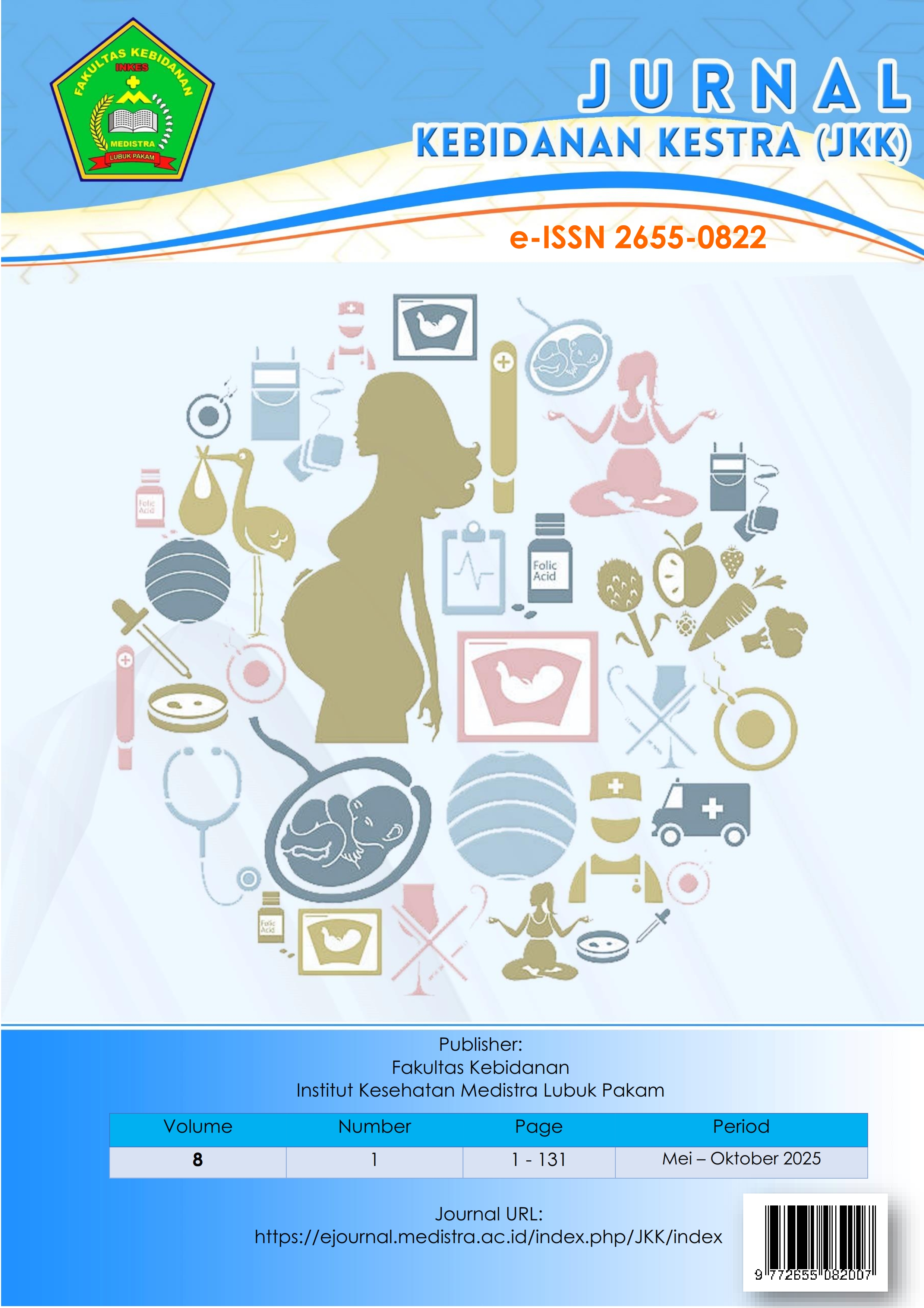Coverage and Determinants of the Success of Antenatal Care (ANC) in First Trimester Pregnant Women at Lubuk Pakam Public Health Center
DOI:
https://doi.org/10.35451/9npbgr94Keywords:
ANC ; Pregnant Women ; First Trimester ; Influencing Factors ; Maternal Health ServicesAbstract
Antenatal Care (ANC) services play a crucial role in the early detection of pregnancy complications, prevention of maternal morbidity and mortality, and overall improvement of maternal and fetal health. High-quality ANC provides opportunities for healthcare providers to conduct screening, health education, and promotive as well as preventive interventions throughout pregnancy. However, its implementation in the field still faces challenges related to service completeness, continuity, and quality. This study aimed to assess the coverage and quality of Integrated Antenatal Care (ANC) services among first-trimester pregnant women at Lubuk Pakam Health Center. A quantitative descriptive design was used with a total sampling technique involving 120 respondents. Data were collected through structured interviews, direct observation, and document review of medical records. The results showed that 78.3% of mothers had attended ANC visits, but only 58.3% received the complete 10T standard services. Laboratory examinations (60%) and referrals (25%) remained below national standards. The dominant factors influencing ANC success were maternal knowledge, family support, and access to health facilities. Therefore, strategies to improve ANC quality should include strengthening laboratory and human resources, providing continuous staff training, and enhancing maternal and family education to ensure optimal and comprehensive antenatal care services.
Downloads
References
[1]. World Health Organization. (2022). WHO antenatal care recommendations for a positive pregnancy experience: Maternal and fetal assessment update. Geneva: World Health Organization.
[2]. World Health Organization. (2023). Trends in maternal mortality: 2000–2023. Geneva: World Health Organization.
[3]. Kementerian Kesehatan Republik Indonesia. (2023). Profil kesehatan Indonesia tahun 2023. Jakarta: Kemenkes RI.
[4]. Badan Penelitian dan Pengembangan Kesehatan. (2022). Riset kesehatan dasar (Riskesdas) 2022. Jakarta: Kemenkes RI.
[5]. Laksono, A. D., et al. (2020). Regional disparities in antenatal care utilization in Indonesia. PLOS ONE.
[6]. Hutapea. (2024). Asuhan kebidanan pada masa hamil, bersalin, bayi baru lahir dan keluarga berencana di praktek mandiri bidan Y.H Kota Pematangsiantar. Medan: Poltekkes Kemenkes Medan.
[7]. Anggraeni, M. D., et al. (2023). Exploring the antenatal care challenges faced during the COVID-19 pandemic in Indonesia. BMC Pregnancy and Childbirth.
[8]. Iskandar, S. I., et al. (2025). Quality of integrated antenatal services: A cross-sectional study in Bantul, Indonesia. PMC Article.
[9]. Yuliyanti, S., et al. (2024). Provider adherence to integrated ANC in primary health care: A mixed-method study.
[10]. Irania, F. (2022). Evaluation of integrated antenatal care implementation. Indonesian Journal of Health Promotion (IJHP).
[11]. Sari, D. W., Handayani, T., & Nugroho, A. (2021). Faktor-faktor yang mempengaruhi kunjungan antenatal care di Puskesmas Sukoharjo. Jurnal Kebidanan Indonesia, 12(2), 115–124.
[12]. Rahman, M., & Yuliani, R. (2022). Hubungan pendidikan ibu hamil dengan kepatuhan kunjungan ANC di wilayah kerja Puskesmas Padangsidimpuan. Jurnal Ilmiah Kesehatan, 10(3), 188–196.
[13]. Utami, D. S., Mardiana, E., & Rahayu, F. (2020). Hubungan status pekerjaan ibu dengan kepatuhan pemeriksaan kehamilan. Jurnal Kebidanan dan Kesehatan, 11(1), 20–27.
[14]. Fitriani, N., Sulastri, R., & Handayani, L. (2022). Determinan kunjungan antenatal care trimester I di Jawa Barat. Jurnal Kebidanan Indonesia, 13(2), 101–110.
[15]. Dewi, P. A., Indrayani, N. L., & Setyowati, T. (2023). Hubungan tingkat pendidikan dan paritas dengan kunjungan ANC awal. Jurnal Kebidanan dan Kesehatan Reproduksi, 10(1), 45–53.
[16]. UNICEF. (2023). Progress on antenatal care coverage: Global maternal health report. New York: UNICEF.
[17]. Nugraha, Y., & Dewi, F. (2021). Analisis sistem rujukan ibu hamil risiko tinggi di Puskesmas wilayah Jawa Barat. Jurnal Sistem Kesehatan, 7(2), 70–79.
[18]. Lestari, D., et al. (2020). Cakupan pemeriksaan ANC terpadu di Kabupaten Sleman tahun 2020. Jurnal Kebidanan Indonesia, 12(3), 145–153.
[19]. Sulastri, R., et al. (2021). Faktor-faktor yang mempengaruhi pelaksanaan ANC terpadu di Puskesmas. Jurnal Ilmu Kesehatan Masyarakat, 9(2), 88–96.
[20]. Susanti, E., & Rahmadani, I. (2022). Hubungan fasilitas kesehatan dengan kelengkapan ANC terpadu. Jurnal Midwifery Update, 10(2), 112–120.
[21]. Wardani, S., & Astuti, L. (2022). Kualitas konseling ANC pada ibu hamil di Kota Surabaya. Jurnal Kebidanan dan Kesehatan, 14(1), 55–62.
[22]. Handayani, et al. (2023). Efektivitas edukasi kelas ibu hamil terhadap kepatuhan ANC. Jurnal Promosi Kesehatan Indonesia, 18(1), 25–33.
[23]. Rahmawati, L., et al. (2020). Kendala pelaksanaan rujukan ANC terpadu di fasilitas pelayanan primer. Jurnal Kesehatan Reproduksi, 11(3), 210–218.
[24]. Nasution, F., & Lubis, L. (2021). Pengetahuan dan perilaku ibu hamil dalam deteksi dini komplikasi kehamilan. Jurnal Kebidanan Medika, 12(2), 77–84.
[25]. Kurniasih, A., Rahmawati, S., & Pratiwi, L. (2023). Pengaruh dukungan suami terhadap kelengkapan kunjungan ANC pada ibu hamil. Jurnal Ilmu Kesehatan Masyarakat, 18(2), 112–119.
[26]. Putri, A. R., & Lestari, E. (2020). Peran dukungan keluarga terhadap perilaku kunjungan ANC di wilayah pedesaan. Jurnal Kesehatan Maternal dan Anak, 6(1), 25–31.
[27]. Rosita, N., Wahyuni, E., & Fitriani, R. (2020). Jarak fasilitas kesehatan dan keteraturan ANC pada ibu hamil di wilayah perdesaan. Journal of Midwifery and Public Health, 8(3), 155–161.
[28]. Simbolon, R., & Panggabean, N. (2022). Akses geografis terhadap layanan ANC di daerah terpencil Sumatera Utara. Jurnal Kesehatan Masyarakat Andalas, 17(1), 30–38.
[29]. Hidayah, R., Mulyani, D., & Putra, Y. (2021). Ketersediaan tenaga laboratorium dan cakupan pemeriksaan ANC di Puskesmas Bengkulu. Jurnal Kesehatan Reproduksi, 9(2), 80–87.
[30]. Rahayu, W., & Dewi, N. (2023). Ketersediaan tenaga kesehatan dan mutu pelayanan ANC di fasilitas primer. Jurnal Pelayanan Kesehatan Primer, 5(2), 101–108.
[31]. Glanz, K., Rimer, B. K., & Viswanath, K. (2020). Health behavior: Theory, research, and practice (6th ed.). San Francisco: Jossey-Bass.
Downloads
Published
Issue
Section
License
Copyright (c) 2025 Nathasia Elga Haryono, Via Wiyana, Martine Agustina Meha, Kurniawati

This work is licensed under a Creative Commons Attribution 4.0 International License.
Copyright in each article is the property of the Author.



























